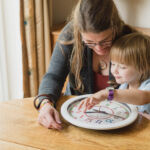
Is your child struggling to read an analogue clock? Perhaps you yourself have had trouble reading the time? For over 20 years, we have been working to make learning how to tell the time on a clock more accessible and enjoyable for children and adults. So, let’s take a look at our two intuitive methods for all learners and how these time-telling processes can transform the way your child understands time.
How to tell the time on a clock
Many children find it difficult to read the time on an analogue clock. This may be something that you have already noticed in your child, or it may be a concern that you are keen to address ahead of the new school year.
We identified these difficulties in children several years ago, and we worked with a group of children to identify the two key causes of their confusion and hesitancy. Both issues come from design flaws on the clocks themselves, as the first is regarding the limited information contained on the face of a clock.
First, regular clocks and watches typically display only hour numbers and some small markings to indicate minutes without actually displaying the 60 minutes within each hour. Whilst this is usually enough information for an experienced time-telling adult to gauge the time, it actually represents just 20% of the information needed to accurately read the time. The remaining 80% – including crucial context like minute details and clear hand positioning – is missing.
The second issue regards the hands of a clock. On most clocks the two hands are often nearly the same length which makes it confusing for people to determine which number to read first. They are also often positioned between numbers, rather than landing on a specific minute marker, which makes it even more challenging to accurately read the time. This lack of clarity makes learning to tell time challenging and frustrating for many children, and for those who struggle with dyscalculia or similar challenges, these struggles can continue long into adulthood.
EasyRead Time Teacher
This is where EasyRead comes in. Our clock face designs carry all the information that is needed to tell the time and each minute of the day is carefully enclosed in separate sections so that the tips clearly point to specific numbers
We also separate the hour and minute sections of the clock into two clear circles, and each hand is enclosed in its own circle to avoid any confusion. So, now that you are familiar with our design, it’s time to take a look at the two simple ways to read an EasyRead clock.
3 step process
Our first method follows the usual process of reading a clock – the ‘past & to’ method. This popular time-telling technique is the one taught in UK primary schools, so if you’re looking to support your little ones’ learning, this is a straightforward method that reinforces their new skills.
Step 1: First, look at the long hand and read the number at the end of it. This number represents the minutes.
Step 2: Next, state whether the minute hand is on the “past” side or the “to” side of the clock. This helps children understand whether the minutes are counting past the current hour or towards the next one.
Step 3: Finally, look at the short hand and read the number at the end to state the hour.
And there you have it! Simple, straightforward, and requiring no guesswork, our structured approach uses all the information available on the clock and makes telling the time an easy game of ‘say what you see’.
2 step process
Perhaps you tell the time another way – as if you’re reading a digital clock? We aim to make learning how to tell the time on a clock accessible for all, which is why we also offer 12/24 hour clocks which only require 2 steps to read.
Step 1: First, look at the hour hand and read the number that it is pointing to.
Step 2: Next, look at the minute hand and read the number at the end.
Say these numbers out loud as you read them to state the current time. For example, if the time is “1:52,” simply say “One, fifty-two.”
How to tell the time on a clock with EasyRead
Which of these methods will work the best for you? Refer back to them as needed and enjoy practising the right method for you with our full range.
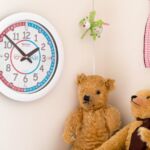
Is your child struggling to contextualise the passage of time on a clock? Understanding this concept can be tricky for young children – particularly if they are unable to see the process’ relevance in the wider world. So, if you are looking for ways to help them grasp this concept and enjoy a fun activity together this summer, learning how to tell the time without a clock is a great way to teach your child about time.
Using the sun’s position
First up: using the sun’s position to work out what time it is. As we all know, the movement of the sun across the sky is actually caused by the movement of the Earth as we orbit the sun, and this daily orbit gives us a good idea of the time at different points in the day.
To get started, take your little one outside in the morning, whilst the sun is still rising in the East. Once they have found the suns’ place in the sky, explain to them that the sun will always be visible in the East before midday, and that if they’re ever stuck without a clock, then they will be able to estimate the time of day by finding the sun’s place in the sky.
At midday, take them outside once again and explain to them that the sun will always be directly overhead at midday, and then finally take them outside again as the sun sets in the West. To conclude the day, explain how, thanks to the rotation and orbit of the Earth, the sun has followed a consistent journey across the sky, and that we are able to estimate what time it is by tracking its movement at different times of the day. This hands-on method helps children to better understand how time follows a consistent pattern and its connection to the Earth’s movements, giving them a tangible representation of time that they will always be able to refer back to.
Making a sundial
Once your child has developed a basic understanding of the sun’s relevance in time-telling activities, you can begin to build upon this understanding by making a sundial. Summertime is the best time to create a sundial as you will have more hours of sunlight to work with, so before your little one wakes up, head out to the garden and find a sunny spot to place a stick upright in the ground. This stick will function as a time telling device, as its shadow length and position will change as the sun’s position changes, making it a great demonstration for any curious child wondering how to tell the time without a clock.
When your child joins you in the garden to begin the activity, mark where the sticks’ first shadow falls with a stone or some colourful chalk. Then make sure that you return to mark the new shadows position at regular intervals throughout the day to create your child’s very own sundial, and make sure that you emphasise to your child that the passage of time is being clearly demonstrated by these markers.
Tracking the North Star
Tracking the North Star is a fascinating way for parents and children of all ages to explore the passage of time by working together to chart the celestial movements. Whilst this concept may seem too challenging for younger children, it follows a similar method to the sundial activity – only this time, we can clearly see that we are the moving object in the night sky.
Start by locating the North Star, also known as Polaris, in the night sky on a warm, clear evening. The North Star is a bright star that remains nearly fixed in the same spot in the night sky whilst the other stars appear to rotate around it due to Earth’s rotation. Point its position out to your child and take a few minutes every hour or so over the next few hours to relocate the star and observe how the surrounding stars appear to change position as the Earth continues to rotate.
Don’t forget to remind your little one that this apparent movement reflects the Earth’s rotation and the passing hours, rather than the movement of the stars, as younger children can become confused if this is not routinely explained to them. Through these observations, children will be able to clearly see the steady, predictable patterns of the night sky and develop their awareness of times’ broader context, as even the stars follow the rules of time every night.
Moon phases
There are two particular ways to use the moon to track the time, and one is best completed over the course of several weeks. However, the less time-consuming activity can be done by tracking the moon’s course over a single night, so if you are planning to do this, start off by noting the time at sunset. If the moon is already visible during this time, then make sure your child clearly notes the moon’s position in the sky as the sun sets.
Over the course of the night the moon will appear to move across the sky as both the Earth and the moon rotate, so regroup once an hour until bedtime to observe the moons’ new position at different times. By comparing the moon’s position to the time of sunset, you can calculate an approximate time based on its position earlier on in the evening.
If you are looking to track the position of the moon across a longer period of time, then engaging your little one in a charting activity is a great way to keep them engaged over the holidays. Begin by observing the moon every night and noting its shape and position, and keep a moon journal to record the moon’s shape each night by shading in the shape. Explain to your child how the moon’s appearance changes due to its orbit around Earth and the varying angles of sunlight hitting its surface to help them grasp longer time periods beyond the daily cycle. Over the course of approximately 29.5 days, the moon goes through its phases: new moon, first quarter, full moon, and last quarter, and by tracking the moon’s phases children are able to see a clear, repetitive system that spans weeks and months.
How to tell the time without a clock
Whilst all of these activities are great opportunities to deepen your little ones’ understanding, it is also clear that the easiest way to tell the time is with an EasyRead clock or watch! As we enjoy watching the movement of the moon, stars, and our own planet through the skies, let’s take a minute to be grateful that our daily routines no longer require us to know how to tell the time without a clock – and that we instead have access to all the time-telling resources that we need.
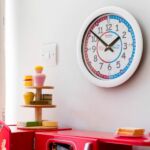
Are you a parent looking for some extra help for your little one as they learn to tell the time? With our full range of educational clocks, including our children’s wall clocks, we are here to transform the learning process into a fun and engaging activity. With their vibrant colours and educational designs, these clocks are made with all the information and support that a child needs to read the time, so join us as we explore how our clocks will improve your child’s abilities.
EasyRead children’s wall clocks
Many young children find learning to read a clock challenging as they are often confused by the hands and numbers, but mastering this skill early on in life is crucial as it gives them the skills that they need to manage their daily routines and independence.
For many, the numbers on a clock are their first introduction to numbers, and telling the time is the first mathematical concept that they encounter, so if you are looking to give your child the support that they need with their learning, then make sure to opt for our clear, child-friendly clocks today.
Here at EasyRead, we understand the struggles that young children encounter when first learning these skills, and we aim to make time-telling quick and simple with our clocks. So, what exactly does our range offer your child?
1. Our teaching methods
As part of our innovative design, we offer two EasyRead formats which allow you to choose the approach that best suits your child’s learning style and preferences, or your own if they have not yet learned a method.
The 12/24-hour format helps children understand the difference between morning and afternoon times, reinforcing their understanding of the daily passage of time and their own schedules. Alternatively, our Past & To method splits the clock into two halves, making it easier for children to understand minutes past the hour and minutes to the next hour. This intuitive design breaks down the complex concept of time into manageable chunks, ensuring that children can learn at their own pace, and with our clear, colour-coded dials and straightforward labelling of numbers, learning the time becomes an engaging and rewarding experience for every child.
2. Colour-coded segments
The face of each one of our clocks is divided into clear sections and features colour-coded segments that clearly distinguish between the hours and minutes. With distinct colours for each hour and minute zone, we have divided up every minute of the day and made it much easier for children to see the difference between hours and minutes, and therefore the relationship between these two measurements. This supports their understanding of time and helps separate it into quantifiable units that can be tracked and measured by following our methods.
Our clear dials therefore carry all the necessary information that children need to learn to tell the time, eliminating any confusion and reducing the need for additional intuition. Children can simply read the time and practice saying it out loud, making the learning process an accessible and straightforward experience that all young learners are able to master and enjoy.
3. Large, easy-to-read numbers
Did you know that conventional clocks actually contain very little useful information for children who are learning this important skill? The average clock design contains only 12 numbers, and hands which aren’t labelled as minute or hours hands, making the majority of these designs confusing or unclear for young children, and causing them to rely on their instincts or assumptions when reading the time.
With large, prominent numbers, EasyRead clocks ensure that children are able to easily see and identify the time, reducing confusion and enhancing their confidence. The gradual gradient of our numbers follows the movement of time, providing a further visual representation of the passing time, and our bold and distinctive numbers mean that children can quickly and accurately read their kids wall clock from anywhere in the room. This design feature supports children in developing their time-telling skills without frustration by encouraging them to practise often and reinforce their learning throughout their days.
4. Engaging and fun design
The bright, engaging, and colour-coded designs offered by these clocks are intended to capture the attention and interest of children in order to engage them in reading the clock. This turns the process into a fun and engaging activity, rather than a chore that has been given to them by their parents or school, and makes them much more likely to interact with the clock and learn.
Additionally, the silent, no-ticking feature ensures that even the most easily distracted children can focus on reading the time without confusion or distraction, and creates a calm learning environment for all those who engage with our designs. So, if your child is often scared by the task of reading an analogue clock, or reacts with panic when you try to teach them, turn the process into a stress-free activity and help them to concentrate by investing in one of our designs today.
5. Support for parents
If you are unsure of which teaching method is right for your child, then don’t worry – we are here to take the pressure off you with our EasyRead 2 or 3-step teaching methods. These intuitive methods are game-changers for parents, as they break down time-telling into simple, manageable steps that are easy for children to understand and follow.
For example:
⦁ Identify the minute hand and say the number that it is pointing to.
⦁ Say which side of the clock the minute hand is pointing to (past or to).
⦁ Identify the hour hand and say the number that it is pointing to.
All of our EasyRead clocks are designed to be quickly and easily read by using these methods and parents can confidently rely on this method to support their child’s learning. As the ideal first clock to help children learn to tell the time at home, our clocks also function as a valuable resource that can be used by the entire family, so make this new activity a shared, enjoyable family experience with our silent, battery powered clocks today.
Tips for Parents
Once you’ve decided on the best kids wall clock for your home, incorporating its use into your family’s daily routine is quick and simple, but it will have an immediate impact on your childs’ skills.
Start by placing the clock in a prominent location where your child spends most of their time, such as in the kitchen, living room, or playroom, and encourage them to use the clock during their daily activities. This doesn’t mean just reminding them to check the time every so often – rather, it means asking them directly to tell you the time throughout the day, or setting small challenges, like timing tasks, or playing ‘what time is it?’ games. You can also ask them to check the time when it’s time for meals, homework, or bedtime and contextualising the use of the clock in this way during their daily activities will reinforce their practical time telling skills.
No matter what activities you opt for, celebrate your child’s successes and continuous improvement to boost their confidence and keep them motivated to learn. Additionally, our full EasyRead range includes a wide selection of resources to complement our children’s wall clocks, including watches, games, online resources, and bedside clocks, so if you are looking to make the learning process even more effective, check out our full range today.
Our Telling Time Clock Range
With their specialist educational design, engaging design features, and supportive teaching methods, our children’s wall clocks make learning fun and stress-free for all children and their families. So, if you’re looking for an educational clock to support your child and improve their abilities, head over to our online shop and find the best telling time clock to boost their confidence and understanding.

It’s important for parents to understand what their child is learning at school. It’s only natural that parents want to help their child be the best they can be. The early years at school are important to a child’s learning growth.
Key Stage 1
Year 1 Programme
In 2014, telling the time was introduced to the National Curriculum. In the early stages of Key Stage 1, children are required to tell the time to the hour and half past the hour and draw the hands on a clock face to show these times. What better way to introduce your child to the concept of time than having your own EasyRead Time Teacher wall clock in your house? The clear and colourful clock face is easy to read and our simple yet effective learning methods will have your child reading the time in a matter of hours.
Year 2 Programme
According to the year 2 programme of study, children should be able to count in multiples of 2, 3, 5 and 10 forwards and backwards. They should also be able to recognise, find, name and write fractions. Our wall clocks will not only help children with counting, they can also assist with fractions. The ¼, ½ and ¾ fractions are easily recognisable on the EasyRead clock face and will help your child understand fractions. In year 2, children are expected to tell and write the time to five minutes including quarter past/quarter to the hour. They should also know the number of minutes in an hour and the number of hours in a day.
Key Stage 2
Year 3 & 4 Programmes
Key Stage 2 builds upon the Key Stage 1 skills. Children will develop their fractions and counting skills. They will also learn to tell and write the time from an analogue clock. Children will also be expected to have a good concept of time. This means they will be able to estimate the time with increasing accuracy to the nearest minute. They will also use vocabulary such as o’clock, am/pm, morning, afternoon, noon and midnight. Our clocks are proven to help children at an early age to grasp the concept of time.
Our EasyRead Time Teacher wall clocks and watches are great for introducing your children to the concept of time so they are prepared for what they are going to be learning at school.
Click here to see the EasyRead wall clocks.
Click here to see the EasyRead watches.

It’s important for parents to understand what their child is learning at school. It’s only natural that parents want to help their child be the best they can be. The early years at school are important to a child’s learning growth.
Preschool and Kindergarten
At preschool age, kids are required to be able to discuss units of time. For example seconds, minutes, hours, days, weeks and years. To be able to do this, kids need to have an understanding of how time works. Having one of our EasyRead wall clocks at home will begin to introduce kids to the concept of time, therefore making their first day at preschool that little bit easier. In Kindergarten, kids will begin to develop their understanding of units of time and will begin to add phrases such as morning, afternoon, next week, in fifteen minutes etc. to their vocabulary.
Grade 1
Kids at this stage should be able to tell and write the time in hours and half hours. They will also be able to describe events in terms of time. This means they will begin to use phrases such as “this morning I…”, “for the first 15 minutes I will be…” and “at 1:30pm I…”
Our EasyRead Time Teacher wall clocks and watches are great for introducing your kids to the concept of time at home so they are prepared for what they are going to be learning at school.
Click here to see the EasyRead wall clocks.
Click here to see the EasyRead watches.

Here at EasyRead Time Teacher, we love hearing feedback from our customers. We have always believed that our customers are our best advert. Take a look at what they are saying about EasyRead:
“The watch I ordered allowed my 9 year old dyslexic daughter to read the time like her classmates for the very first time! It has made such a significant difference to her life.”
“I would highly recommend this clock if your child has difficulty understanding how to tell the time – I wish I’d had something like this when I was a child!”
“My daughter has an EasyRead watch, we bought the matching clock and they really help with her understanding.”
“My five year old daughter learned to tell the time in five minutes!”
“Fantastic watch! My Granddaughter can’t wait to go to school wearing hers!”
“Excellent, daughter is very happy! She learnt time within two days. The watch is very sturdy, highly recommended.”
“Best watch I’ve ever purchased for my daughter.”
“What a brilliant watch!! So easy to read and builds children’s confidence. I would recommend this watch to everyone!”
“Great products and excellent quality for the money!”
Would you like to see what all the fuss is about? Click here to view all our EasyRead products.
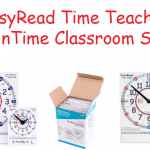
TwinTime offers a whole different method of teaching children how to tell the time. Here at EasyRead, we understand how difficult teaching the time can be – especially in a classroom full of excitable children. Our products are proven and trusted by hundreds of schools and thousands of teachers.
We recommend pairing the TwinTime Teacher Edition with the TwinTime Student Edition however this isn’t essential, our system works just as effectively if you purchase one or the other.
The TwinTime Teacher Edition was designed so teachers can stand at the front of a classroom to demonstrate setting the time with the moveable hands. It is wipe on wipe off so you can also write the time underneath the clock.
The TwinTime Student Edition is smaller than the Teacher Edition – perfect for children. They are perfect for children to work in groups or individually for setting the time on the clock face and then writing the time underneath.
As well as telling the time, TwinTime is also useful for counting forwards and backwards from 30, for learning fractions and counting in 5s and 10s.
Our 2 and 3 step teaching systems will work perfectly with TwinTime in teaching children how to tell the time. Take a look at them here.
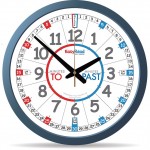
So you’ve bought your EasyRead Time Teacher clock…now what?
Practice makes perfect! Our clocks are designed to be taken off the wall and interacted with. Children will love the ‘hands on’ learning and then, seeing it every day up on the wall, they can practice and cement their learning.
We have even put the teaching methods on the back of the clock to make life as easy as possible! The simple design is brilliant for young children trying to get to grips with telling the time.
Take a look at our classroom clocks here.
Download our free resources here.
If you need any help or have any questions, please email us on [email protected] or call on 07865 470905.
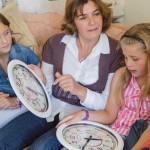
EasyRead Time Teacher believe in practice makes perfect. When children master something as difficult as telling the time, they need to cement that skill with practice. We have the solution.
Having an EasyRead classroom clock on your wall encourages children to practice on their own, in their own time. Children love to take ownership of their learning and will be running to the clock to practice their new skills!
As well as our brilliant products, we also offer numerous free learning resources such as clock colouring sheets, our two step and three step systems and our video library.

Teaching a classroom full of children to tell the time is tricky. So we created EasyRead TwinTime – great for schools.
Our new EasyRead TwinTime is a ‘hands on’ resource for children learning to tell the time. It is a teaching and learning resource perfect for teachers to demonstrate setting and telling the time on a clock face.
Pair the TwinTime Student with the Teacher Edition for an educational but fun lesson plan. The PVC clock cards are wipe on wipe off so children can practise setting the time on the clock face and writing the time underneath. You can also use our TwinTime products for teaching fractions.
Learn both ‘minutes past and minutes to’ and ’12 and 24 hour’ methods with our double sided teaching resources. We are trusted by hundreds of schools and thousands of teachers.
Click here to see our Student Edition here.
Click here to see our Teacher Edition here.
Use our simple yet effective two step teaching method for ‘12 and 24 hour’ and our three step teaching method for ‘minutes past and minutes to’.







